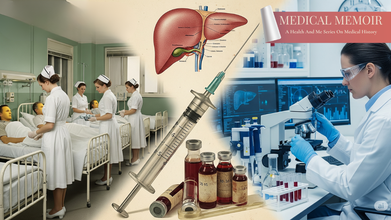- Health Conditions A-Z
- Health & Wellness
- Nutrition
- Fitness
- Health News
- Ayurveda
- Videos
- Medicine A-Z
- Parenting
Medical Memoir: Before COVID, Hepatitis Was The Mystery Virus That Haunted Generations

Credits: Health and me
'Medical Memoir' is a Health & Me series that delves into some of the most intriguing medical histories and unveils how medical innovations have evolved over time. Here, we trace the early stages of all things health, whether a vaccine, a treatment, a pill, or a cure.
You think this is a history lesson, but let’s do some math. What does Hepato‑ (“liver”) + ‑tropic (“infecting and replicating in the liver”) + DNA (HBV genome) equal? That spells hepatitis—a mystery virus long misunderstood, long before COVID dominated headlines.
This isn’t just linguistic trivia. It’s a journey through centuries of medical detective work, flawless missteps, and public health triumphs—all centered on one family of viruses that quietly reshaped liver medicine and modern virology.
Early Clues in Jaundice and Contagion
Hepatitis didn’t appear on a microscope slide in the 20th century—it was described millennia earlier. Ancient Greek physician Hippocrates observed jaundice as a distinctive yellowing of skin and eyes. By the 8th century, medical writers suspected jaundice was contagious, hinting at an infectious agent at work in the liver.
Between the 17th and 19th centuries, dramatic epidemics of jaundice spread through soldiers and navies. Shared living quarters, contaminated water, and later, mass inoculation campaigns and reused syringes during wars linked the outbreaks to bloodborne transmission. By 1885, physicians recognized that transfused blood could carry the mysterious jaundice-causing pathogen. And when measles and yellow fever vaccinations during World War II triggered outbreaks, it became clear: an unseen virus replicated in bloodstreams—and in the liver.
This early history underscored two enduring facts: hepatitis came in different forms, and it was stealthy, delayed, and extremely hard to track.
Naming a Virus in Two Parts
By mid-century, researchers sought to categorize the illness. In 1947, MacCallum introduced a dual classification that would shape all future work: Viral Hepatitis A (infectious, via contaminated food or water) and Viral Hepatitis B (serum-borne, via blood and body fluids). That breakthrough turned a single symptom—jaundice—into a family of diseases with different transmission pathways and prevention needs.
Modern hepatitis history truly began in the 1960s. In 1963, Baruch Blumberg identified the Australia antigen (HBsAg) in Aboriginal Australians and hemophiliac blood donors using immunologic screening. It was the first direct marker for Hepatitis B virus, revealing a virus that lay dormant in carriers, often for decades.
The story advanced quickly:
1970 – The Dane particle (complete HBV virus) was visualized, proving the viral identity.
Early 1970s – Researchers described the HBeAg, another disease marker.
1973 – Hepatitis A virus (HAV) was isolated, confirming two different viruses.
Suddenly, hepatitis was no longer a vague syndrome—it was a family of identifiable pathogens. That scientific clarity laid the foundation for prevention and treatment.
Finding a Cure Before HCV With Plasma‑Derived Vaccines
The early HBV vaccine story is unique. Developed from human plasma, it became the first vaccine not produced via tissue culture, licensed under the name Heptavax in 1981. That innovation paved the way for recombinant vaccines, but the achievement stood alone for a time. Taiwan’s national HBV vaccination program, launched in 1984, offered powerful proof of impact:
HBV carrier rate dropped from 9.1% to 2.7% among children.
Rates of pediatric hepatocellular carcinoma plummeted from 27% to 17%.
Effectively, this was the world’s first anti-cancer vaccine. The vaccine didn’t just stop liver infection—it significantly reduced childhood liver cancers in real populations.
The C Virus and the Molecular Breakthrough of 1989
In 1989, the hepatitis world shifted again. A team led by Choo, Kuo, and Houghton unveiled Hepatitis C virus (HCV) using molecular cloning techniques—no tissue culture, electron microscope, or serology required. It was the first virus discovered solely via genetic methods.
That breakthrough explained persistent post‑transfusion hepatitis cases, intravenous drug-user outbreaks, and a heavy burden of global liver disease. It was the start of a new era: molecular virology, where pathogens were identified by their RNA alone.
Soon came discoveries of HDV (delta virus), HEV, and GBV‑C/HGV (hepatitis G virus). This growing catalog of viral types clarified why hepatitis symptoms varied and why prevention needed multiple strategies.
From Unproven Remedies to Modern Antivirals
Mid-20th-century treatment was often worse than the disease: prolonged bed rest and steroids were used for acute hepatitis until controlled trials in the ’60s showed they caused harm. In chronic cases, steroids lingered until the 1980s, when researchers clearly proved they worsened outcomes.
By the early 1990s, interferon alpha offered the first real antiviral option. In 1998, lamivudine appeared, followed by more potent nucleoside analogues in the 2000s. For chronic HBV, these drugs allowed suppression of the virus with daily pills—a huge leap in quality of life. HCV treatment advanced spectacularly:
- Pegylated interferon plus ribavirin drove cure rates into the 40–60% range.
- Protease inhibitors like boceprevir and telaprevir added another 30%+ success.
- By the 2010s, direct-acting antivirals (DAAs) offered cure rates above 85–90% within a few months, without interferon.
- Chronic HCV became the only curable chronic viral infection—a feat comparable in scope to eradication campaigns for smallpox or polio.
Globally today, over 300 million people live with chronic HBV or HCV and over 1.3 million die annually from liver cirrhosis, cancer, or hepatitis complications.
In response, the World Health Organization’s 2022–2030 strategy aims to reduce new infections by 90% and deaths by 65%. It underscores the urgent need for universal vaccinations, access to testing, and treatment—especially in low-income settings across Asia and Africa, without coordinated action, projections warn:
- 9.5 million new infections,
- 2.1 million liver cancer cases,
- 2.8 million deaths by 2030.
Yet history offers reason for optimism: the leaps science made over just a few decades show what’s possible—with political will, investment, and global partnerships.
HBV opened new pathology understanding by linking to polyarteritis nodosa. HCV revealed risks beyond the liver: cryoglobulinemia, non-Hodgkin lymphoma, metabolic disorders like Type II diabetes, and altered lipid profiles. Hepatitis viruses reshaped fields ranging from rheumatology to oncology.
The discoveries required collaboration—and some competition—across labs and continents. The story of hepatitis is one of scientific rivalry, teamwork, serendipity, and intellectual persistence. That blend of curiosity and rigor transformed a family of mysterious illnesses into preventable and treatable diseases.
Long before COVID captured global focus—before masks, PCR tests, and lockdowns—hepatitis was a mystery virus that haunted generations. It caused jaundice, silent liver failure, and cancer. It eluded diagnosis, lacked vaccines, and spread undetected.
Yet through a combination of linguistic insight, molecular science, epidemiology, and public health action, the world unraveled its secrets—one virus at a time.
Today, hepatitis is no longer an invisible threat. It's a medical triumph—because when science is patient, and public health persistent, even the most elusive pathogens can be conquered. The story isn't over, but it's a testament to what decades of dedication and discovery can achieve.
Scromiting: Unusual Symptom Caused By A Deadly Cannabin Condition; All You Need To Know

Credits: iStock
Scromiting is taking up the space in headlines now. Before 2025 comes to an end, this single symptom caused by a deadly cannabis condition has got everyone talking about it.
The deadly cannabis hyperemesis syndrome (CHS), is now formally designated by the World Health Organization (WHO), and the unique and unusual symptom is scromiting: a mix of screaming and vomiting. Thanks to social media, this word is making a buzz and have distorted what people should actually know about the condition.
The WHO has formally named CHS in October, which was after a decision adopted by the Centers for Disease Control and Prevention (CDC) that will help doctors track the prevalence of the condition and get a better picture of adverse events.
Scromiting and CHS: How Did It Make A Big News?
The conversation reignited after a study published in the Journal of the American Medical Association in late November reported that CHS cases remain elevated. The study noted that cyclic vomiting is a related symptom and confirmed that emergency department visits tied to CHS saw a notable rise between 2016 and 2022, particularly in 2020 and 2021. During those two years, researchers identified 188 million emergency department visits among adults aged 18 to 35, with CHS appearing more frequently among heavy cannabis users.
The Origin Of CHS
CHS was first identified in Australia in 2004, yet nearly two decades later it remains poorly understood. It typically affects people who use marijuana daily or near daily for more than a year, leading to episodes of severe nausea, repeated vomiting, abdominal pain and a compulsive desire to take extremely hot showers or baths. Many patients report that heat temporarily eases their symptoms, although doctors say the relief is often short-lived.
What Are The Doctors Saying?
Dr Sam Wang, a pediatric emergency medicine specialist and toxicologist at Children’s Hospital Colorado, described treating patients who arrive exhausted and doubled over in pain after hours of vomiting, as reported by CNN. Many tell doctors they tried taking a scalding hot shower before coming to the hospital but found it offered little relief. The National Institutes of Health has said this hot water reliance appears to be a learned behavior that can become a compulsion.
Despite the surge in awareness, the term “scromiting,” a blend of screaming and vomiting, has sparked its own controversy. Some social media users argue the sudden buzz is exaggerated or anti-cannabis fearmongering. Others say the phenomenon has been known for years. Natashia Swalve, a neuroscience professor at Grand Valley State University, told Axios that “scromiting” is not a clinical term, just a catchy label that gains traction every few years. She warned that sensational language fuels confusion at a time when misinformation about CHS is already widespread.
Health experts say CHS episodes can last for days and recovery may take weeks or even months, depending on overall health, eating habits and whether the person stops using marijuana. Continuing to use cannabis can quickly trigger symptoms again. A study from George Washington University found that nearly half of surveyed patients had been hospitalized at least once because of CHS, and many reported using marijuana more than five times a day before symptoms began. Starting cannabis at an early age was linked to a higher likelihood of developing the condition.
The renewed scrutiny of CHS comes as the United States faces rising infections from norovirus, sometimes called “winter vomiting disease,” another illness known for causing sudden, intense vomiting. While unrelated, the overlapping symptoms have added to public confusion around what exactly is driving widespread reports of stomach distress.
Researchers emphasize that CHS is real, although many questions remain unanswered, including why hot showers feel soothing and how much cannabis use puts someone at risk. They say more clinical awareness is urgently needed. Better screening for cannabis use and recognizing symptom patterns could help reduce misdiagnosis and guide patients toward the only proven treatment: stopping marijuana use.
Why Women Love To Take Very Hot Shower, According To Doctor

Credits: iStock
For years, people have joked about how women seem to enjoy showers that could probably cook noodles. If you are someone who loves cranking up the water temperature until the bathroom looks like a steam room, you may have wondered whether there is an actual reason behind it. According to UK surgeon and content creator Dr Karan Rajan, the answer lies in biology. Women are not simply choosing scalding showers for fun. Their bodies are wired differently, and that affects how they experience temperature.
Higher Core Body Temperature
Dr Rajan explains that, on average, women have a slightly higher core body temperature than men. It might sound like this would keep them warmer, but in reality, it does the opposite. When the core is warm but the surrounding environment is cool, that contrast makes cold air feel even colder. So a mildly chilly room may feel more uncomfortable for women, leading them to turn to hotter showers to compensate.
This idea has gone viral online. In a popular TikTok clip, creator couple Micah and Sarah joked about preparing for a shared shower. Micah pretended to train for the extreme heat by dipping his hand in boiling water. The internet quickly chimed in with comments like “My husband says I am training for hell” and “He calls it lobster time”. The jokes were relatable because many couples experience this temperature divide, but not many knew the science behind it until now.
Hormones Add to the Chill
Hormones play a major role too. Estrogen affects blood flow to the extremities, which includes hands, feet and even earlobes. Research shows that women’s extremities can be up to three degrees colder than men’s. Dr Rajan points out that this becomes more noticeable during ovulation when estrogen levels peak. Women on hormonal birth control may also experience increased sensitivity because estrogen stays higher for longer periods.
So even when the core stays warm, the toes and fingers may feel unusually cold. A very warm shower becomes a quick and comforting fix for this temperature imbalance.
Lower Metabolic Rates
Another biological factor is metabolic rate. Women generally have a lower resting metabolic rate than men, meaning they produce less body heat throughout the day. This naturally makes them feel colder and more drawn to hotter water while bathing. Women also tend to have more body fat and less muscle mass, which influences how the body responds to temperature changes.
What Doctors Say
Australian GP Dr Jasmina Dedic Hagan supports these findings, as reported in Body and Soul. She explains that women typically have warmer cores, cooler skin, and a higher layer of insulating fat around the body. On top of that, they have reduced circulation in the extremities because the body prioritises keeping reproductive organs warm. With less muscle mass, the body’s heat-producing brown fat does not function in quite the same way as it does in men.
So Is It Just Preference?
Not entirely. While some women truly enjoy the sensation of a very hot shower, much of it is tied to biology. From hormones to metabolism to circulation, several factors work together to make warmer showers feel soothing and sometimes even necessary. So the next time someone teases you about loving lava-level water, you can tell them it is simply science at work.
Should I Take A Shower When I'm Sick?

Credits: iStock
When you are burning up, even a simple shower can feel confusing. Should you cool your body quickly with cold water or soothe your aches with something warm? Fever is a natural defense mechanism, but the symptoms it brings can make you feel miserable. The right water temperature can help ease discomfort and support your recovery.
Below is a simple breakdown of how fever affects your body, followed by practical shower tips and additional ways to safely bring your temperature down.
How Fever Resets Your Body’s Thermostat
During an infection, your immune system releases chemicals called pyrogens. These signals tell the hypothalamus, which is your internal thermostat, to raise your core temperature. The added heat slows the growth of certain viruses and bacteria and helps immune cells work more efficiently.
This temperature rise is why you feel:
- Chills as your body works to reach the new set point
- Sweating when the fever begins to settle
- Faster heart rate and quicker breathing, which increase fluid loss
Knowing this matters because water that is too cold can trigger intense shivering, which drives your temperature higher. Water that is too hot can widen your blood vessels and increase sweating, which may worsen dehydration.
Cold, Lukewarm, or Hot: Which Shower Helps Most?
Each water temperature works differently with a fever. Understanding these differences helps you choose what your body needs at that moment.
Cold showers cool your skin quickly. They may feel refreshing if you are overheated, but they often trigger shivering. That shivering can raise your core temperature and is especially risky in children.
Lukewarm or tepid showers are the safest choice for most people with fever. This temperature allows gentle heat loss through the skin without causing shivering. It helps you cool down gradually while keeping your body comfortable.
Warm or hot showers can help relieve muscle aches or sinus congestion, especially for adults. However, they can increase sweating and may slightly raise your temperature. Avoid them if you are already overheated or dehydrated.
Simple Shower Tips When You Have a Fever
- Start with lukewarm water to safely reduce temperature and ease discomfort.
- If you feel flushed and sweaty, splash cold water only on pulse points such as the wrists and neck.
- Use warm showers only for congestion relief and follow up with hydration and light clothing.
- If you feel dizzy, sit on a chair outside the shower and let steam fill the bathroom while you take a gentle sponge bath.
Other Safe Ways to Bring Down a Fever
Rest
Your body is already working hard to fight the infection. Light activity can raise your temperature further, so give yourself time to rest and recover.
Stay Hydrated
Fever increases the risk of dehydration, especially if you have vomiting or a poor appetite. Sip water, oral rehydration solutions, or electrolyte drinks. Chilled fluids can also help lower your temperature.
Stay Cool
Keep your room slightly cool and wear loose, breathable clothing. If you have chills, use a light blanket but avoid overheating. You can place a cool cloth on your forehead or under the arms for short intervals.
Medication
Over the counter fever reducers like acetaminophen and ibuprofen can safely lower fever. Always follow dosage guidelines. Avoid aspirin in children because it can lead to Reye's syndrome.
What Not to Do
- Do not take cold showers or ice baths because they trigger shivering and can raise your temperature.
- Avoid alcohol rubs since the alcohol can be absorbed through the skin.
- Do not take extra doses of fever medicine thinking it will work faster.
- Always read medication labels carefully to avoid accidental overdosing.
© 2024 Bennett, Coleman & Company Limited

